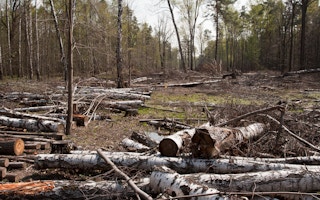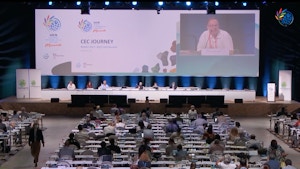When the Covid-19 pandemic first struck, and national governments responded with lockdowns of varying degrees, conservationists warned it would lead to a surge in illegal logging in tropical countries. They argued that with fewer eyes and ears on the ground for monitoring, combined with a ready supply of short-term labor in the form of unemployed people migrating from cities back to their home villages, the world’s rainforests were bound to take a hit.
Indeed, environmental campaigners interviewed by Mongabay in June 2020, just a few months into the pandemic, said their organisations had already detected signs of increased illegal activity.
But according to new research in Forest Policy and Economics, different forces acting on the global macroeconomics have largely balanced each other out, so that increases in deforestation in one part of the world have been offset by decreases elsewhere.
Global Forest Watch (GFW) found that tropical forest tree cover dropped by 12.2 million hectares (30.5 million acres) in 2020, a 12 per cent increase over levels in 2019, according to the new paper. That’s an area nearly the size of Greece.
But the researchers write that the analysis should focus on a “three-year moving data average, which with the large 2016-18 declines was still dropping in 2020.” This is because rates of loss in 2020 were still considerably below those in 2016 or 2017, so the three-year average of 2018-2020 is much lower than the two previous periods (2016-2018 and 2017-2019).
Trends in the three largest tropical forest countries — Brazil, the Democratic Republic of Congo (DRC) and Indonesia — continued largely unaffected by the Covid-19 crisis.
There were three main drivers on the global economy during the pandemic, all pushing in different directions: supply-side shortages, demand reductions, and then the impact of government financial packages to stimulate economies.
“We find that deforestation-curbing and -enhancing factors so far just about neutralised each other,” the authors report.
The paper questions other studies that linked reports of increasing deforestation with the pandemic. A study by WWF Germany, it notes, found that forest disturbance alerts rose by 77 per cent in the period February-June 2020 compared with the same period in the years 2016-2019. WWF attributed the increase to “accelerated loss of forest governance and increased land grabbing during government lockdowns.”
Other reports, such as the one by Mongabay referenced earlier, “causally combined” Global Land Analysis and Discovery (GLAD) tropical forest data with anecdotal accounts of deforestation, the paper notes.
“The general problem with these studies’ reasoning is timing,” the authors write. “Many tropical countries had not yet adopted lockdown measures when registering higher GLAD alerts; in fact, countries with the largest rise in the February/March deforestation alerts, such as Colombia or Thailand, only experienced lockdowns by end-March. This mismatch in timing effectively invalidates any lockdown-attributable explanation.”
Lead author Sven Wunder, principal scientist for the European Forest Institute, told Mongabay in an interview that, even now — more than a year and a half since the pandemic struck — it is too early to say what the long-term impact of Covid-19 will be.
“We have had this very strong fiscal response which has dominated things, but that can’t continue as it is,” Wunder said. “If they taper these stimulus programmes, what will happen then?”
Historically, a booming economy nearly always leads to increasing deforestation, because it stimulates greater commodity demand and more investment in land-use projects, Wunder said. The money injected into the world’s economy since the Covid-19 pandemic struck has dwarfed responses to other global crises, such as the great recession of 2008 or the US Marshall Plan, the aid programme to Western European countries to help their economies recover after World War II.
The paper’s figures show that the size of stimulus packages in major European countries such as France, Germany and the UK has been 10 times what they put into their economies in 2008. But Wunder says measures can’t continue like this and that there won’t be a boom decade as there was during the 1920s, following the end of World War I and the Spanish flu pandemic.
Frances Seymour, a senior fellow with the World Resources Institute (WRI), told Mongabay that Wunder’s paper provided a useful perspective on the overall impact of the pandemic on global deforestation rates, but was surprised by one point.
“It was interesting to note that they discount a 12 per cent increase in tree cover loss in primary forests loss as insignificant,” she said. “When you had the rest of the world economy contracting, and you can still have a 12 per cent uptick, that’s amazing. It is an indicator of the resilience of the various drivers that do lead to forest loss.”
Seymour added that her concern in the long term is that environmental issues will be pushed farther down the list of priorities as governments try to help their economies recover following the impact of the pandemic.
“When governments are in a crisis, they understandably focus on short-term job creation schemes as opposed to thinking about the sustainability of those jobs,” she said. “There’s also a tendency to become more protectionist so you are not so dependent on the global economy. Both of these things are bad for forests.”
Daniel Carrillo, forest campaign director for the Rainforest Action Network (RAN), says there is clear evidence that fiscal stimulus programmes are further fueling unsustainable business practices. In recent months, he said, the two biggest Asian pulp and paper companies, Asia Pacific Resources International Ltd (APRIL) and Asia Pulp & Paper (APP), have both announced mill expansion plans.
APRIL’s proposed expansion of its pulp production capacity to 5.8 million metric tons a year in Sumatra, Indonesia, could put 120,000 hectares (300,000 acres) of natural forests at risk, according to analysis by one environmental group. APP’s OKI mill in southern Sumatra will more than double in size under its proposals to ramp up production capacity to 7 million metric tons a year.
“The fiscal stimulus is happening and at the same time, these two companies announce these expansion plans, and we see these two things as being linked,” Carrillo told Mongabay. “These plans trouble us because, for decades, pulp mills have been responsible for deforestation, land conflicts and violations of Indigenous people’s rights.”
Now, Carrillo said, it is important that world leaders address the issue of how to make recovery programmes more sustainable at the COP26 climate change summit in Glasgow, Scotland, in November.
“There is an opportunity to look at the impacts of this fiscal stimulus and how Indigenous communities were left out of it,” he said.
The pandemic has made those at the forefront of protecting forests more vulnerable, said Aina Grødahl, senior adviser with the Rainforest Foundation Norway, which has mapped the consequences of the coronavirus pandemic among 60 Indigenous and environmental groups in tropical rainforest countries.
“Measures resulting from the pandemic, such as lockdown and martial law, have impaired the ability of environmental police and other societal functions to crack down on land invasions and illegal activities,” she said.
Seymour says the single biggest impact of Covid-19 could be how it affects the popularity of world leaders such as Jair Bolsonaro, the controversial president of Brazil. Bolsonaro was enacting policies that were damaging to the Amazon Rainforest long before the coronavirus appeared, but now it’s a question of whether the pandemic—and how Brazil has responded to it—has boosted or undermined him.
“The likelihood of Bolsonaro being reelected—it’s that dynamic that’s most important for the future of the Amazon,” she said.
This story was published with permission from Mongabay.com.





















